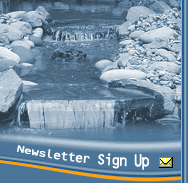 |

Downs By The Pond
86663 Bailey Hill Road
Eugene, OR 97405
Phone: 541-521-7389
Email
Us
|
|
|
Waterfall Basics
- Waterfall
- Support for the waterfall rocks
- Mortar & Spray Foam
1. Waterfall Top
The waterfall is a crucial area to get right. A waterfall with lots
of splash looks and sounds pretty, but can cause significant water
loss. Many times ponds that appear to have a leak are really losing
water from splash-out.
|
|
2. Support for the waterfall
rocks Top
If you are going to build a hill for your waterfall, remember that
freshly dug soil is light and airy and will settle over time. It
is important to create a support which will not settle under the
weight of rocks and environmental conditions (rain). as a pile of
dirt straight out of the pond will do.
Our support looks a lot like a stairway as it is formed. We use a
support of 8 x 8 x16 concrete cinder blocks under the liner or platforms
created from sand bags to support the weight of the rock. The soil
from the excavation can then be used to backfill and cover this structure.
If your soil is particularly nasty, use it up to fill the holes in
the cinder blocks or a base for good planting soil.
Joining Liners
The liners should be laid like shingles, the upper liner on top.
Clean the area to be joined with unleaded gas or liner primer. It
will evaporate without leaving residue. Place double sided tape between
the layers and roll firmly with a hand held roller to ensure adhesion.
Then clean the overlapped joint. Place single face tape over the
top and roll. Use lap seam caulk in a fine bead to seal the edges.
We like to inspect the seam before covering with rocks.
|
|
3. Support for the waterfall
rocks Top
When using mortar to seal the voids between the rocks, care should
be given that the mortar does not dry too quickly, which can cause
separation from the rocks and cracking. Mortar should be mixed to
a consistency which will stick to vertical surfaces. Two good choices
are:
Blue-Line mortar which is fast setting, enabling you to test water
over the fall sooner. This mortar sets up very quickly, so only mix
a small portion at a time to avoid waste.
Non-shrink grout is also a good choice. It's dry time is slower,
but it has less shrinkage so there will be less separation from the
rocks.
We sometimes mix the two together for optimum working conditions.
Mortar and concrete will leech lime into the water raising the pH,
so it is important to either leech with vinegar water or treat with
Muratic Acid.
Spray foam can also be used to seal rocks in the waterfall. It is
non-toxic and will not have to be sealed or leeched. This product
now comes in black as well as to the standard cream color. Spray
foam can be tricky to work with as it has a tendency to grow beyond
the size you wish the joint to be. The cream colored variety often
needs to be painted if visible since it will turn yellow with age.
Also, many people have reported that after 2-3 years, it starts to
degrade, and no longer holds the water in place. When working with
spray foam, wear disposable gloves.
Don't forget the level! Be sure to use a level to check that the
rocks are setting correctly. The rocks should be horizontally level
and tilt down slightly to the front from the back for the most attractive
water flow. Small stone shims can be used to keep the rocks level
while they are mortared or spray foamed.
|
|
|
|
|











